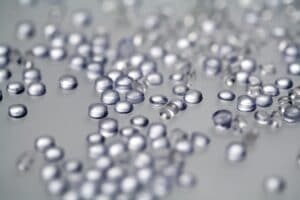Choosing between polycarbonate and glass is a crucial decision when designing products that require transparent materials. Both materials offer advantages and disadvantages, and the selection depends on the specific application and project requirements.
What is Polycarbonate?
Polycarbonate is a thermoplastic polymer derived from carbonic acid, known for its high strength and transparency. Discovered in the 1920s and commercially used since the 1960s, polycarbonate is employed across various industries, including construction, automotive, medical, optics, and electronics. It can be processed through extrusion to create sheets and profiles, or injection molding to produce items such as lenses, headlights, and chairs. Its main qualities include excellent mechanical, thermal, and electrical properties.
Polycarbonate should not be confused with PMMA (Plexiglass), as explained in Differences Between Plexiglass and Polycarbonate.
Advantages of Polycarbonate
- Polycarbonate is highly impact-resistant: a 4mm sheet can withstand forces up to 200 J, making it 20 times stronger than glass. This makes it ideal for applications requiring durability, such as protective covers or barriers.
- Its flexibility is another advantage: PC sheets can be cold-bent and shaped, allowing for curved structures without needing complex equipment.
- It is much lighter than glass, reducing structural load and making transport and installation easier.
- Polycarbonate also offers good thermal insulation: extruded sheets with a cellular structure help retain heat, improving energy efficiency in buildings.
- Moreover, polycarbonate is a recyclable material, capable of being transformed into new products.
- It is also highly versatile and easy to work with, allowing it to be cut, bent, extruded, or molded with ease.
- Through extrusion, various types of polycarbonate sheets, tubes, and profiles can be created, such as profiles for LED lighting or profiles for glass walls and partitions.
- Its physical, mechanical, and optical properties, combined with its ease of processing, have enabled the design of previously unthinkable products like CDs and DVDs, transparent helmets, transparent tubes, chairs, and components for the automotive and medical industries.
Disadvantages of Polycarbonate
- Despite its many advantages, polycarbonate has some drawbacks.
- Although transparent, it offers lower clarity compared to glass, making it less suitable for applications where perfect optical clarity is required.
- It is also more prone to scratches than glass and often requires surface treatments to improve scratch resistance.
- Polycarbonate’s maximum operating temperature is 120°C, making it unsuitable for applications that require resistance to higher temperatures.
- Without UV protection, polycarbonate tends to yellow over time, compromising its appearance and transparency.
- Lastly, the material is sensitive to various chemicals, which can damage it in harsh environments, limiting its use compared to glass.
Advantages of Glass
- Glass is renowned for its superior transparency, making it the ideal choice for applications where visual clarity is essential, such as windows, curtain walls, optical lenses, windshields, and light bulbs.
- Glass is also highly resistant to chemicals, making it suitable for use in industrial and harsh environments, as well as in the food industry for glasses, bottles, and containers.
- Another advantage of glass is its heat resistance: it can withstand temperatures up to 200°C, surpassing polycarbonate.
- Glass is also easy to clean and does not get damaged easily during cleaning, maintaining its transparency.
- Moreover, it is fully recyclable, making it an environmentally sustainable choice.
Disadvantages of Glass
- However, glass is brittle and can break easily upon impact, requiring greater care in handling and more robust support structures compared to polycarbonate.
- Additionally, its heavy weight complicates installation, increasing labor costs and requiring more complex engineering solutions.
- Finally, glass is generally more expensive than plastic materials, both in terms of purchase and installation, which can affect overall project costs.
Polycarbonate vs Glass: Which is Better?
The choice between polycarbonate and glass depends on the specific application.
Glass is unmatched in terms of transparency and chemical resistance, making it ideal for windows, windshields, curtain walls, and light bulbs.
On the other hand, polycarbonate excels in applications requiring impact resistance, flexibility, and lightness, such as curved canopies, skylights, or design projects, portholes, lenses, lamps, transparent helmets, headlights, CD holders, mobile phone components, protective shields, and parts for the automotive and medical industries.
Conclusion
There is no absolute winner between the two materials. The final decision should be based on the specific characteristics of each material and the project’s requirements. Both glass and polycarbonate can offer optimal solutions when used in the right circumstances.
Submit your request for an extruded polycarbonate profile
Fill out the form to request a quote or personalized consultation. Discover how we can help bring your ideas to life.


